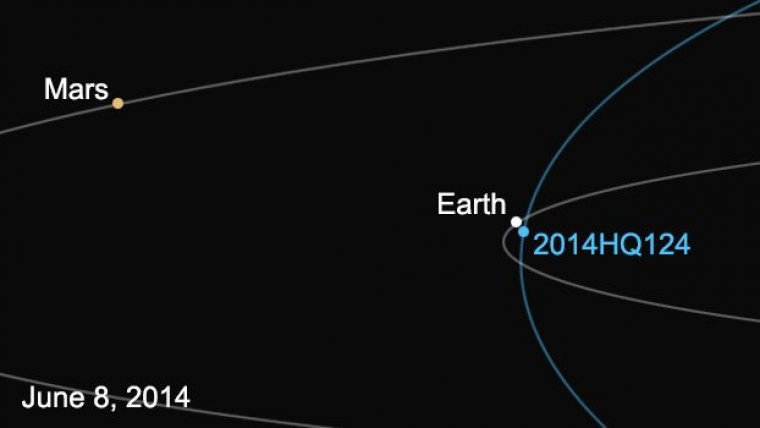| News / Space News |
Asteroid discovered by NASA to pass Earth safely
NASA | JUNE 7, 2014
A newfound asteroid will safely pass Earth on June 8 from a distance of about 777,000 miles (1.25 million kilometers), more than three times farther away than our moon.

This diagram shows the orbit of asteroid 2014 HQ124, and its location relative to Earth on June 8. Image Credit: NASA/JPL-Caltech
Designated 2014 HQ124, the asteroid was discovered April 23, 2014, by NASA's NEOWISE mission, a space telescope adapted for scouting the skies for asteroids and comets.
The telescope sees infrared light, which allows it to pick up the infrared glow of asteroids and obtain better estimates of their true sizes. The NEOWISE data estimate asteroid 2014 HQ124 to be between 800 and 1,300 feet (250 and 400 meters).
More than one hundred follow-up observations from NASA-funded, ground-based telescopes and amateur astronomers were used to pin down the orbit of the asteroid out to the year 2200, during which time it poses no risk to Earth. Its trajectory will continue to be recalculated past that time frame as additional observations are received.
2014 HQ124 is designated a "potentially hazardous asteroid," or PHA, which refers to those asteroids 460 feet (140 meters) in size or larger that pass within 4.6 million miles (7.4 million kilometers) of Earth's orbit around the sun. There are currently 1,484 known PHAs, but none pose a significant near-term risk of impacting Earth.
NASA detects, tracks and characterizes asteroids and comets passing close to Earth using both ground- and space-based telescopes. The Near-Earth Object Program, commonly called "Spaceguard," discovers these objects, characterizes a subset of them and identifies their orbits to determine if any could be potentially hazardous to our planet. To date, U.S. assets have discovered more than 98 percent of the known near-Earth objects.
YOU MAY ALSO LIKE


